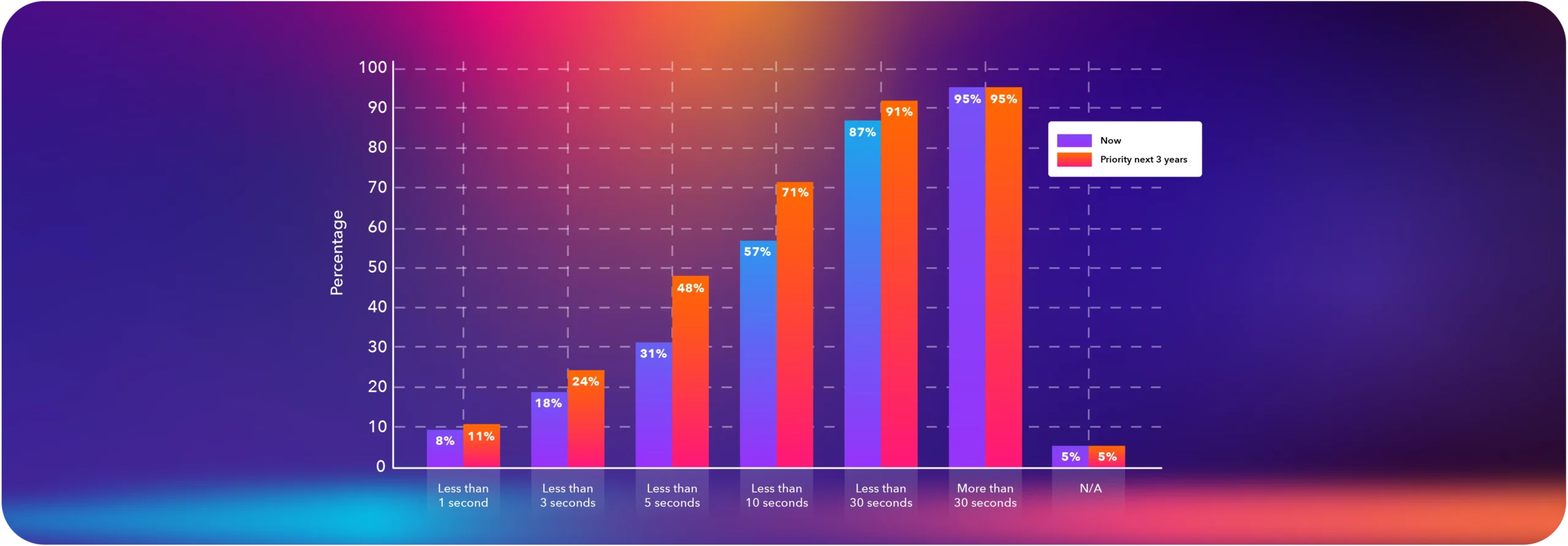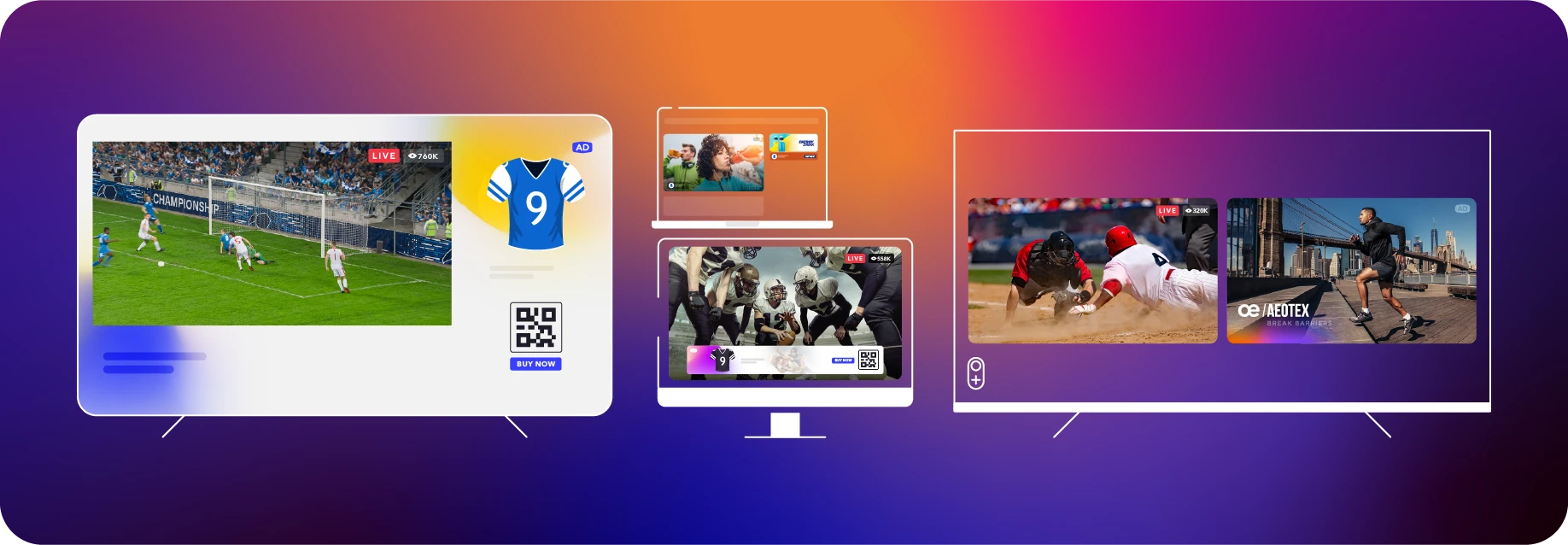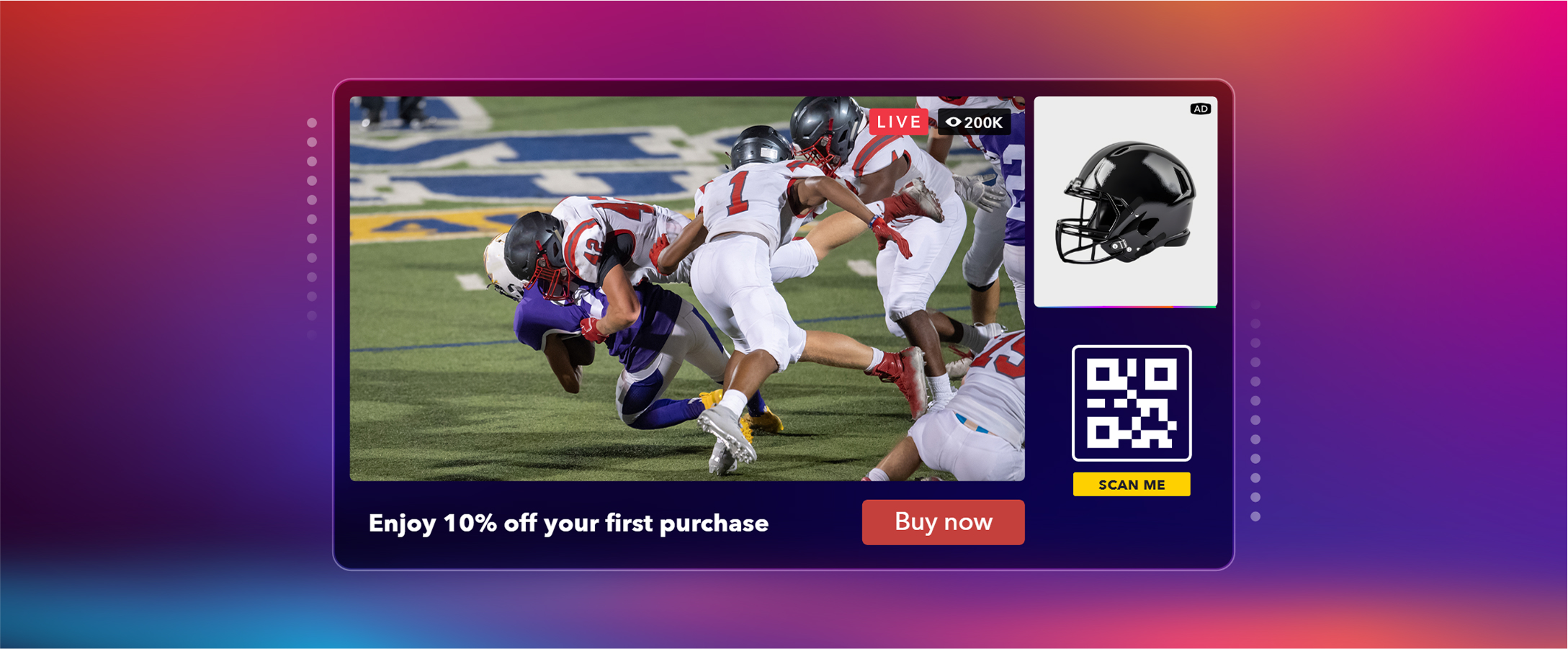Ad-insertion as a key monetization strategy
Monetization is essential for streaming platforms to stay sustainable. 69% of sports streaming services are using ad-supported models like FAST (Free Ad-Supported Streaming TV) and AVOD (Advertising Video on Demand), according to recent market research from Stream TV Insider. These models are also viewed as the top priority for future growth. This means, ad-insertion continues to play a key role in the monetization strategy for sports streaming platforms.
The push for lower latency streaming
As live sports streaming becomes more mainstream, low latency is emerging as a top priority for platforms aiming to deliver a truly immersive fan experience. Unlike on-demand content, live sports are time-sensitive. Fans expect to see the action unfold in near real-time. Even a few seconds of added delay can lead to “spoiler effects,” where viewers hear about exciting moments, like a goal, a buzzer-beater, or a key play, through social media or push notifications before seeing them on screen. That kind of delay or inconsistency can lead to a poor fan experience and cause people to stop watching.
To meet rising viewer expectations, streaming platforms are increasingly investing in low latency streaming technologies that minimize delays. According to research from Stream TV Insider, 31% of sports streaming providers currently offer latency under 5 seconds, a number expected to grow to 48% over the next three years. This shift toward low latency is critical for keeping fans emotionally engaged with live action and enhancing real-time social viewing experiences. However, achieving low latency is technically demanding. In fact, 77% of respondents from the sports streaming study identified minimizing latency as their top technical challenge. It outranks other issues like scalability, stream quality, and other infrastructure concerns.

Figure 1: Sports streaming latency—today & expectations for the next 3 years
The challenges of ad insertion for low latency streams
In addition to the challenge of achieving low latency, integrating ads into low-latency live streams introduces another layer of complexity. The big question is: how can we do ad insertion effectively in low-latency streaming? To answer this question, we’ll look at how sports streaming platforms handle ad insertion today, the limitations of current methods, and explore newer technologies that offer better solutions.
Today, Server Side Ad Insertion (SSAI) is a widely used ad-insertion approach in live sports streaming. In these cases, ads are pre-scheduled on the server side and triggered during live playback. The server stitches the ads into the video content on the server side before delivery. While SSAI can be effective for on-demand or linear content, it still has several limitations when applied to low latency environments.
Increased latency and slower startup times
SSAI often introduces latency because all ads must be prepared before playback begins. This includes time-consuming steps like ad decisioning, retrieving and encoding ad content, loading a heavy manifest file, and repackaging the stream. This added overhead delays stream initialization, resulting in slower startup times when viewers begin playback. Additionally, the need to constantly refill and update manifest files for the video player contributes to ongoing latency.
These issues are particularly problematic in low-latency live streaming, where immediacy is critical. In such workflows, media segments are shorter and delivered more frequently, leaving very little time for ad stitching. Any delay or mismatch in this process can cause playback interruptions, disruptions that are especially noticeable and detrimental during live events.

Constraints on personalization at scale
Typically, ads delivered via SSAI are pre-scheduled and lack personalization. To enable personalized ads with SSAI, publishers need to build infrastructure that allows client-side data to be sent from the client side. This data is then used to perform server-side personalization, generating unique ad streams for each viewer. However, this approach is technically complex and costly to scale, as server load increases proportionally with the number of viewers.
In low-latency environments, the challenge intensifies. The full personalization process, including manifest manipulation and ad retrieval, typically takes 10 seconds or more. However, low-latency streaming workflows allow for a very short response window from the live action, leaving insufficient time to complete these operations. As a result, implementing personalized ads via SSAI in such environments is practically unfeasible, making it a major limitation for low latency streaming scenarios.
Risk of interrupting the live experience
Since ads are planned in advance with SSAI, there’s no room to adjust or cancel ad breaks in real time. The process takes time—ad decisioning, fetching the ad, transcoding it, and stitching it into the stream.
In low-latency settings, there’s no room for delays. Trying to make last-minute changes could interrupt the live stream or cause playback issues. This rigidity makes it difficult to respond to dynamic events during a live stream, risking interruptions during exciting moments like a sudden spike in viewers or a key play in the game.
Why SGAI is designed for low latency streaming
Server Guided Ad Insertion (SGAI) is a hybrid ad insertion method that combines the benefits of both server-side and client-side approaches. It leverages server-side guidance to indicate where ad breaks should occur, while the client-side video player handles the actual stitching and playback of ads.
Consistent latency and faster start up times
SGAI enables faster stream startup and consistent latency by avoiding the need to preload a heavy manifest filled with pre-scheduled ads. Unlike SSAI, it doesn’t require all ads to be prepared in advance. Instead, the video player dynamically calls for ads and coordinates their insertion during playback. This streamlined approach allows the content to begin playing immediately, without waiting for ad decisioning or manifest updates. Because SGAI operates in real time and doesn’t introduce additional processing overhead. It maintains a steady latency profile, making it ideal for low-latency live streaming where timing and responsiveness are critical.
Scalable personalization at low latency
Recent research from Stream TV Insider found that 63% of respondents see ad personalization as the biggest opportunity in sports streaming, ranking it above all other monetization strategies.
One of the key advantages of SGAI is its ability to deliver highly personalized ad experiences at scale without compromising on speed. In SGAI, the video player has direct access to client-side insights such as the viewer’s device type, screen size, and user preferences. This allows the player to generate and send a rich, detailed ad request to the server almost instantly.
By shifting personalization closer to the client, SGAI reduces round-trip time, enabling faster ad decisioning and delivery. This makes it far more suitable for low-latency streaming, where ads must be fetched and inserted in real time without disrupting the viewing experience. As a result, each viewer receives more relevant and engaging ads without buffering or delay.
In addition, SGAI makes this highly scalable. Unlike SSAI, which places increasing load on the server as the number of viewers grows, SGAI offloads much of the personalization logic to the client side. This means that even as audience size increases, the server isn’t burdened with rendering unique ad streams for every viewer. The result is a more cost-effective, resilient, and scalable solution that delivers personalized experiences without compromising performance.
Flexible scheduling and real-time control
Timing is everything in live sports streaming—and that includes ad delivery. One of the key advantages of SGAI is its ability to give publishers real-time control over when and how ads are inserted, ensuring they never interrupt the most exciting moments.
Unlike traditional SSAI, where ad breaks are pre-scheduled and fixed in the manifest, SGAI allows for dynamic scheduling and cancellation. Publishers can plan ad breaks in advance, but also adjust on the fly based on what’s happening in the stream. For example, if a game-winning goal is about to be scored or a dramatic moment is unfolding, a scheduled ad can be instantly skipped to preserve immersive viewer experiences. Conversely, a new ad break can be triggered in real time, using API calls or SCTE-35 markers, prompting the player to fetch and insert the most relevant ad content.
Ad triggers can occur anytime before a scheduled break. When there’s enough notice, personalized ads can be fetched and delivered smoothly. But in low-latency environments, triggers may arrive with little warning. In these cases, solutions like Dolby OptiView Ads play a preloaded “bumper ad” to ensure a seamless experience while the personalized ad is prepared in the background.
To ensure smooth playback and minimal disruption, bumper ads are always kept ready. Publishers can also pre-select the content of these bumper ads to align with their brand and audience preferences. This level of adaptability is especially crucial in live sports, where every moment counts. By ensuring that ads never interfere with the most emotionally charged or high-stakes parts of the broadcast, SGAI helps preserve the integrity of the viewing experience while still maximizing monetization opportunities around it.
| Server-Side Ad Insertion | Server-Guided Ad Insertion | |
|---|---|---|
| Viewer experience | Prone to ad break interruptions and added latency | Smooth playback with consistent low latency & no interruptions |
| Personalization | Limited personalization capabilities | Highly personalized ad delivery |
| Ad scheduling flexibility | Low flexibility; ads must be pre-scheduled | High flexibility; supports real-time ad scheduling |
| Scalability | Complex and costly to scale | Simple, efficient, and cost-effective at scale |
Table 1: Comparison of SSAI and SGAI for low-latency live stream ad insertion
Bonus benefits with SGAI for live sports streaming
Fan-first ad formats for live sports streaming
To preserve the excitement of live sports streaming, SGAI supports a range of innovative ad formats that integrate smoothly into the viewing experience without interrupting the action. Unlike traditional full-screen ad breaks that pause or replace the stream, these formats are designed to keep the game visible and uninterrupted.
For example, overlay ads appear on top of the video without pausing the stream, while double-box ads allow the live content to continue playing in a window alongside the ad. Similarly, the L-shape layout positions ad content around the video frame ensures the stream remains fully visible. All these new ad formats are already pre-built into end-to-end SGAI solutions like Dolby OptiView Ads.
These non-intrusive formats maintain viewer immersion while still delivering strong value to advertisers. By keeping the live content front and center, SGAI opens up more monetization opportunities and enables monetization that feels natural, respectful of the fan experience, and aligned with the fast pace of live sports.

Content insertion for stronger fan connection
Beyond ad insertion, SGAI also enables the delivery of personalized, complementary content to enhance the live sports experience. For example, it is possible to show real-time highlights or scores from other ongoing games, or surface flashbacks of historic moments involving a player or team relevant to the current action, adding context, emotion, and deeper fan connection.
Conclusion
SGAI is an ad insertion technology that is designed for low-latency streaming, making it ideal for live sports where timing is everything. It enables timely, personalized ads without disrupting the viewing experience. By coordinating client-side and server-side components, SGAI delivers ads seamlessly, ensuring a consistent low latency. This keeps fans immersed in the action while giving publishers more control, better ad performance, and new monetization opportunities.
In the high-stakes world of live sports, where attention is fleeting and expectations are high, SGAI empowers platforms to deliver personalized, non-disruptive ad experiences. Solutions like Dolby OptiView Ads don’t just represent a technical upgrade—they offer a strategic advantage that boosts fan loyalty and long-term engagement.









